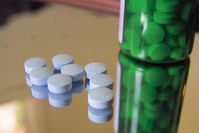You routinely administer combination drugs..but do you know what's in them? To find out, match each combination of ingredients in Section II with its correct name in Section 1.
SECTION I
1. Timolide (Merck)
2. Lufyllin-GG (Wallace)
3. Esgic (Forest)
4. Allegra D (Aventis)
5. Excedrin PM (Bristol-Myers Squibb)
SECTION II
a. each 15 ml contains: dyphylline, 100 mg guaifenesin, 100 mg
Used to relieve bronchospasm in patients with chronic bronchitis or emphysema, this drug contains dyphylline, a xanthine-derivative bronchodilator, and guaifenesin, an expectorant. Teach your patient to take doses after meals to reduce the risk of gastrointestinal upset.
b. fexofenadine HCl, 60 mg; pseudoephedrine, 120 mg
This extended-release tablet is prescribed to relieve allergy symptoms and nasal congestion. Fexofenadine is a second-generation nonsedating antihistamine; pseudoephedrine is a decongestant. Warn your patient not to take over-the-counter products that contain an antihistamine or a decongestant while taking this drug.
c. timolol maleate, 10 mg; hydrochlorothiazide, 25 mg
Indicated to control hypertension, this combination contains timolol, a nonselective beta-blocker, and hydrochlorothiazide, a thiazide diuretic. Tell your patient to report difficulty breathing, which can occur with beta-blocker use.
d. diphenhydramine citrate, 38 mg; acetaminophen, 500 mg
This nonprescription combination promotes sleep and relieves minor aches and pains. Diphenhydramine, a first-generation antihistamine and the most sedating one available, is used to produce drowsiness. Acetaminophen, a nonopioid analgesic, relieves pain. Warn your patient not to use this combination with other products that contain an antihistamine and not to take it with alcohol.
e. acetaminophen, 325 mg; caffeine, 40 mg; butalbital, 50 mg
Prescribed to relieve various types of headaches, this combination contains acetaminophen, a nonopioid analgesic; caffeine, to enhance the analgesic effects of acetaminophen; and butalbital, a short-acting barbiturate that provides sedation. Warn your patient that he could experience dizziness and drowsiness while taking this drug.
ANSWERS: 1c, 2a, 3e, 4b, 5d.
Marcy Portnoff Gever is an independent pharmacist consultant and educator in Ringoes, N.J.
Copyright Springhouse Corporation Apr 2003
Provided by ProQuest Information and Learning Company. All rights Reserved



